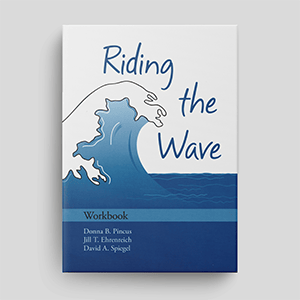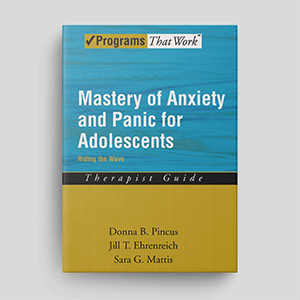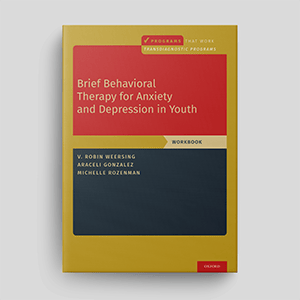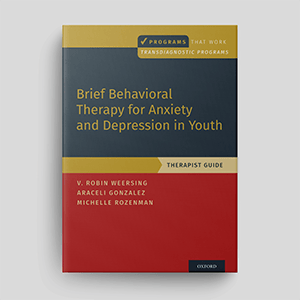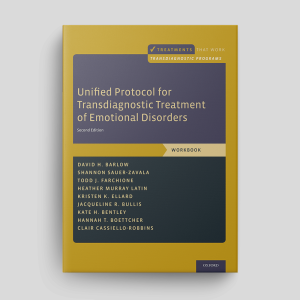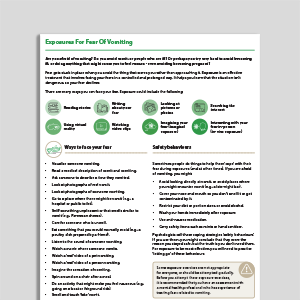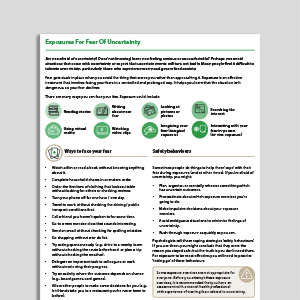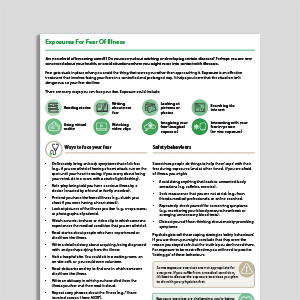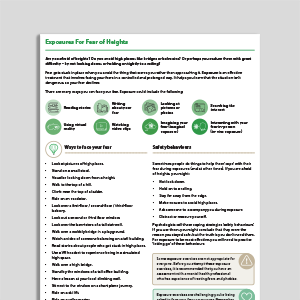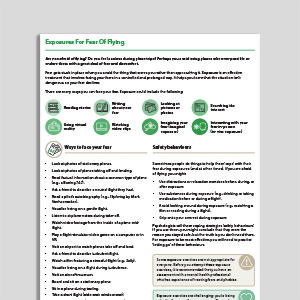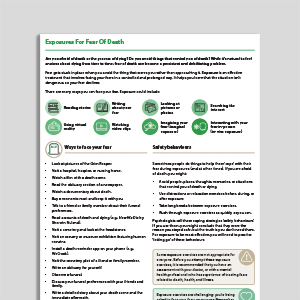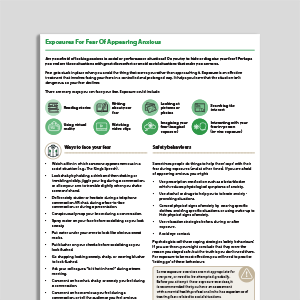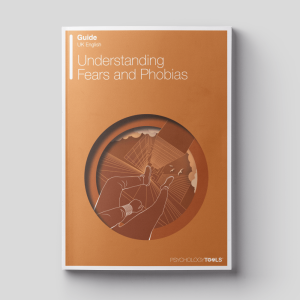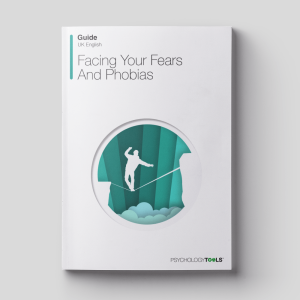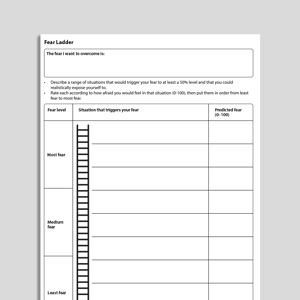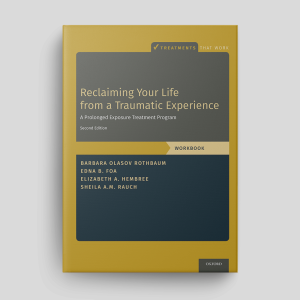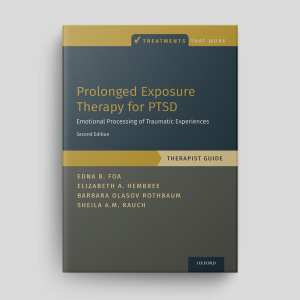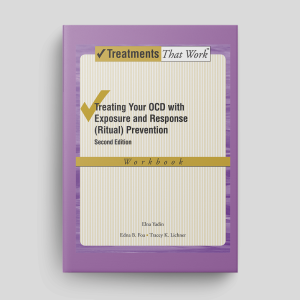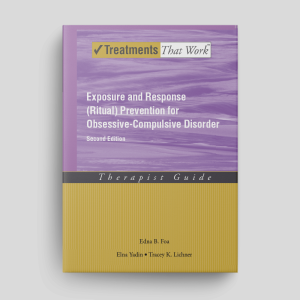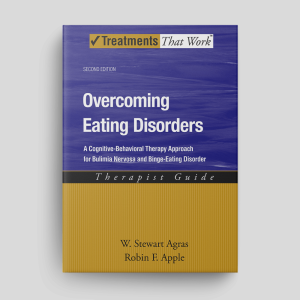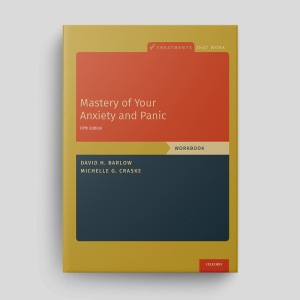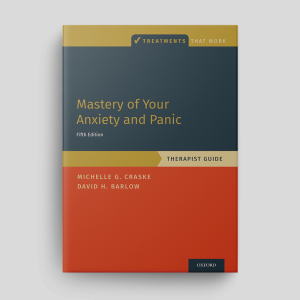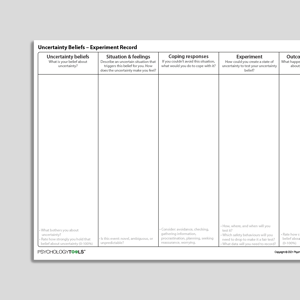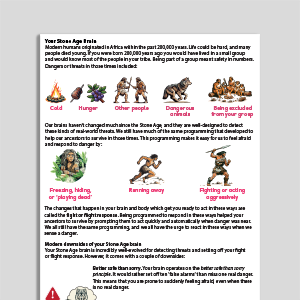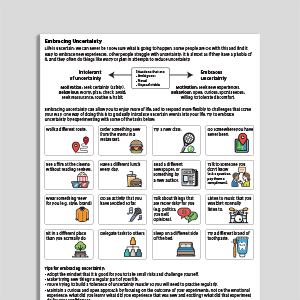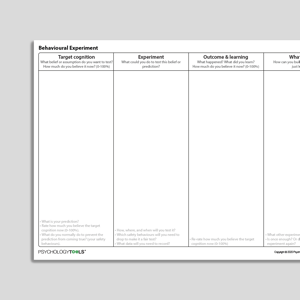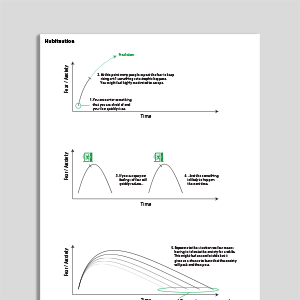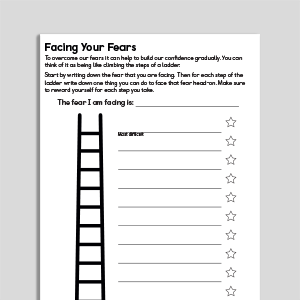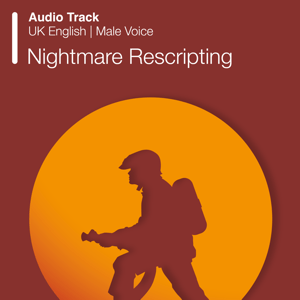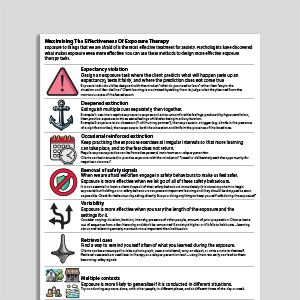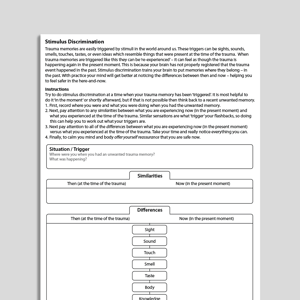Exposure
Exposure is a psychological intervention with its roots in behavior therapy (Marks, 1978). It is considered to be the most effective psychological technique for the treatment of fear and anxiety. Exposure therapy embodies the ‘face your fears’ maxim and involves encouraging clients to repeatedly face an object or situation which causes them anxiety. Exposure therapy is an essential component of evidence-based cognitive-behavioral therapy (CBT) treatments for phobia, panic disorder, post-traumatic stress disorder (PTSD), obsessive compulsive disorder (OCD) and social anxiety disorder.
The traditional way of understanding what was happening during exposure therapy was grounded in the idea of habituation. Habituation means that the “original reaction towards the stimulus diminishes in intensity or even disappears” (Eelen & Vervliet, 2006). Most people are familiar with everyday examples of habituation such as being aware of the sound of a fan when it is turned on and then automatically ‘tuning out’ the noise so that you are not aware of it a few minutes later. The traditional goal of exposure therapy was fear habituation – exposure trials were continued for as long as was necessary for a patient to report a significant reduction in fear. Therapists would typically aim to wait prolong exposure until a 50% reduction in subjectively reported fear (Kendall et al, 2005).
Showing 1 to 50 of 58 results
Mastery of Anxiety And Panic For Adolescents: Riding The Wave: Therapist Guide
Mastery of Anxiety And Panic For Adolescents: Riding The Wave: Therapist Guide
Brief Behavioral Therapy For Anxiety And Depression In Youth: Workbook
Brief Behavioral Therapy For Anxiety And Depression In Youth: Workbook
Brief Behavioral Therapy For Anxiety And Depression In Youth: Therapist Guide
Brief Behavioral Therapy For Anxiety And Depression In Youth: Therapist Guide
Unified Protocol for Transdiagnostic Treatment of Emotional Disorders (Second Edition): Therapist Guide
Unified Protocol for Transdiagnostic Treatment of Emotional Disorders (Second Edition): Therapist Guide
Unified Protocol for Transdiagnostic Treatment of Emotional Disorders (Second Edition): Client Workbook
Unified Protocol for Transdiagnostic Treatment of Emotional Disorders (Second Edition): Client Workbook
Exposures For Fear Of Vomiting
Exposures For Fear Of Vomiting
Exposures For Fear Of Uncertainty
Exposures For Fear Of Uncertainty
Exposures For Fear Of Losing Control Of Your Mind
Exposures For Fear Of Losing Control Of Your Mind
Exposures For Fear Of Illness
Exposures For Fear Of Illness
Exposures For Fear Of Heights
Exposures For Fear Of Heights
Exposures For Fear Of Flying
Exposures For Fear Of Flying
Exposures For Fear Of Death
Exposures For Fear Of Death
Exposures For Fear Of Breathlessness
Exposures For Fear Of Breathlessness
Exposures For Fear Of Body Sensations
Exposures For Fear Of Body Sensations
Exposures For Fear Of Appearing Anxious
Exposures For Fear Of Appearing Anxious
Understanding Fears And Phobias
Understanding Fears And Phobias
Facing Your Fears And Phobias
Facing Your Fears And Phobias
Managing Social Anxiety (Third Edition): Workbook
Managing Social Anxiety (Third Edition): Workbook
Managing Social Anxiety (Third Edition): Therapist Guide
Managing Social Anxiety (Third Edition): Therapist Guide
Reclaiming Your Life From A Traumatic Experience (Second Edition): Workbook
Reclaiming Your Life From A Traumatic Experience (Second Edition): Workbook
Prolonged Exposure Therapy For PTSD (Second Edition): Therapist Guide
Prolonged Exposure Therapy For PTSD (Second Edition): Therapist Guide
Treating Your OCD With Exposure And Response (Ritual) Prevention (Second Edition): Workbook
Treating Your OCD With Exposure And Response (Ritual) Prevention (Second Edition): Workbook
Exposure And Response (Ritual) Prevention For Obsessive Compulsive Disorder (Second Edition): Therapist Guide
Exposure And Response (Ritual) Prevention For Obsessive Compulsive Disorder (Second Edition): Therapist Guide
Cognitive Behavioral Treatment of Childhood OCD: It's Only a False Alarm: Workbook
Cognitive Behavioral Treatment of Childhood OCD: It's Only a False Alarm: Workbook
Cognitive Behavioral Treatment Of Childhood OCD: It's Only A False Alarm: Therapist Guide
Cognitive Behavioral Treatment Of Childhood OCD: It's Only A False Alarm: Therapist Guide
Overcoming Eating Disorders (Second Edition): Therapist Guide
Overcoming Eating Disorders (Second Edition): Therapist Guide
Mastery Of Your Anxiety And Panic (Fifth Edition): Workbook
Mastery Of Your Anxiety And Panic (Fifth Edition): Workbook
Mastery Of Your Anxiety And Panic (Fifth Edition): Therapist Guide
Mastery Of Your Anxiety And Panic (Fifth Edition): Therapist Guide
Overcoming Your Eating Disorder: Workbook
Overcoming Your Eating Disorder: Workbook
What Are Safety Behaviors?
What Are Safety Behaviors?
Uncertainty Beliefs – Experiment Record
Uncertainty Beliefs – Experiment Record
Intolerance Of Uncertainty
Intolerance Of Uncertainty
Maximizing The Effectiveness Of Exposure Therapy
Maximizing The Effectiveness Of Exposure Therapy
What Is Imagery Rescripting?
What Is Imagery Rescripting?
What Is Exposure Therapy?
What Is Exposure Therapy?
What Is EMDR? (Eye Movement Desensitization and Reprocessing) – (Archived)
What Is EMDR? (Eye Movement Desensitization and Reprocessing) – (Archived)
Links to external resources
Psychology Tools makes every effort to check external links and review their content. However, we are not responsible for the quality or content of external links and cannot guarantee that these links will work all of the time.
Exercises
- Facing your fears: Exposure | Anxiety Canada
Information (Professional)
- Interoceptive Exposure Definition | White, Basden, Barlow
- Narrative Exposure Therapy (NET) | Shauer, Neuner, Elpert
- Prolonged Exposure (PE) | Edna Foa
Presentations
- Family affair: involving a partner or spouse in exposure and response prevention for OCD | Jonathan Abramowitz | 2018
- Interoceptive exposure: an underused weapon in the arsenal against obsessions and compulsions | Jonathan Abramowitz | 2018
- Using exposure to treat PTSD: why, when, and how? | Fyvie
Recommended Reading
Health anxiety
- Walker, J. R., Furer, P. (2008). Interoceptive exposure in the treatment of health anxiety and hypochondirasis. Journal of Cognitive Psychotherapy, 22(4), 366-378
What Is Exposure?
A more modern understanding of the effectiveness of exposure therapy is grounded in learning theory, specifically models of inhibitory learning. According to learning theory the extinction of fear is a form of associative learning. During exposure therapy, when a patient repeatedly confronts a fear-inducing stimulus (conditioned stimulus: CS) without a terrible consequence happening (unconditioned stimulus: US) their expectancies are altered such that they no longer expect the US to follow the CS, and their behaviour is altered so that they approach rather than avoid. Inhibitory learning theory (Lang, Craske & Bjork, 1999) proposes that the original threat association learned during fear acquisition (CS predicts US) is not erased by the new learning. Instead, the CS becomes an ambiguous stimulus with two meanings that both live in memory and compete for retrieval (called the ‘retrieval competition’). ILT is powerful because it explains why fear can easily return even after successful completion of treatment, and because it has been used to develop ways of conducting exposure therapy which are even more effective (see Craske et al, 2008). For a comprehensive guide to conducting effective exposure therapy see our worksheet Maximizing The Effectiveness of Exposure Therapy or read our article Delivering more effective exposure therapy in CBT.Types of exposure
Exposure therapy can be practiced in a variety of forms:In-vivo exposure: In-vivo exposure describes exposure to a feared object or situation in real life. Examples of in-vivo exposure might include inviting a person with a phobia of spiders to look at pictures of a spider, or to hold a small spider in their hand. Other examples of in-vivo exposure include site visits by people with post-traumatic stress disorder (PTSD) where they revisit the scene of a trauma.
Imaginal exposure: Sometimes it is impossible or impractical to conduct exposure in-vivo. Imaginal exposure consists of inviting a patient to hold the feared object or situation in their imagination. They might be asked to describe the stimuli or scenario in considerable detail. Imaginal exposure is a technique used in the treatment of PTSD – often called ‘reliving’ or ‘revisiting’ the patient is asked to give a detailed verbal account of their traumatic event from beginning to end in the first person present tense. Imaginal exposure is also used in the treatment of worry and OCD – patients are asked to describe and write details of a feared scenario in detail, and then to read the scenario or listen to an audio recording of it.
Virtual reality or computer-aided exposure: Exposure to feared situations in a realistic computer simulation is becoming increasingly prevalent alongside technological advances. This can be a helpful approach when exposure to the real object or situation is impractical, and may prove to be a form of treatment which is more effective in terms of therapist resource.
Interoceptive exposure: Fear and avoidance of particular body sensations is a core component of panic disorder, amongst other conditions. Interoceptive exposure describes the practice of deliberately inducing particular body sensations with the aim of fear extinction. Examples of interoceptive exposure exercises include deliberate hyperventilation to bring on respiratory alkalosis, or staring at oneself in a mirror for a prolonged period to induce feelings of unreality.
Graded exposure: Graded exposure describes the process of developing a fear hierarchy, from least-feared to most-feared, and introducing patients to exposure trials of increasing difficulty. Graded exposure is less important than previously thought – developments in inhibitory learning theory indicate that factors such as variability of exposure and the creation of expectancy violation effects are more helpful therapist targets.
Flooding: Flooding describes a prolonged and intense version of exposure in which a client is exposed directly to the object or situation which they find most frightening until the fear habituates. In modern times flooding is not practised widely.
Exposure with response prevention: Exposure and response prevention (ERP) is a treatment for obsessive compulsive disorder (OCD) in a patient is exposed to their feared situation and encouraged not to engage in their typical neutralizing response. For example, a patient with a fear of contamination might be encouraged to touch a door handle, or the inside of a wastepaper basket, and encouraged not to wash their hands.
References
Craske, M. G., Kircanski, K., Zelikowsky, M., Mystkowski, J., Chowdhury, N., & Baker, A. (2008). Optimizing inhibitory learning during exposure therapy. Behaviour Research and Therapy, 46(1), 5-27.
Eelen, P., & Vervliet, B. (2006). Fear conditioning and clinical implications: What can we learn from the past? In M. G. Craske, D. Hermans, & D. Vansteenwegen (Eds.), Fear and learning: From basic processes to clinical implications. (pp. 17–35). Washington, DC US: American Psychological Association.
Kendall, P. C., Robin, J. A., Hedtke, K. A., Suveg, C., Flannery-Schroeder, E., & Gosch, E. (2005). Considering CBT with anxious youth? Think exposures. Cognitive and Behavioral Practice, 12(1), 136-148.
Lang, A. J., Craske, M. G., & Bjork, R. A. (1999). Implications of a new theory of disuse for the treatment of emotional disorders. Clinical Psychology: Science and Practice, 6(1), 80-94.
Marks, I. M. (1978). Exposure treatments: Clinical applications. In Behavior modification: Principles and clinical applications (pp. 204-242). Little, Brown Boston.
